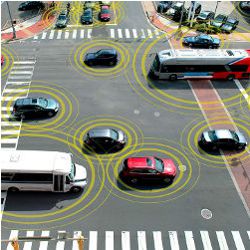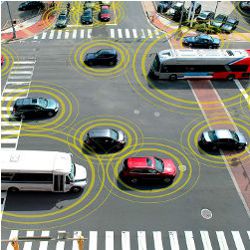
Driverless cars are the news media’s darlings, promising commuters an extra hour’s sleep as they whiz down the world’s highways. Yet technologies that assist your ride rather than control it will be part of our automotive experience long before this robot-chauffeured vision comes to fruition. Onboard sensors such as backup cameras already extend our senses by allowing us to observe the world directly; now, vehicle-to-infrastructure (V2I) and vehicle-to-vehicle (V2V) technologies—collectively known as "V2X"—stand poised for widespread adoption, appearing in new-model cars as early as 2016, and they are likely to be required eventually, despite current consumer fears.
Like back-up cams, V2X technologies promise safety advantages even if fully driverless cars never become a reality. A report released by the U.S. Department of Transportation (DOT) in August posited that two specific V2V applications would prevent more than 500,000 crashes and 1,000 deaths per year in the U.S.: "Intersection Movement Assist" (IMA), which warns of cross-traffic at intersections, and "Left Turn Assist" (LTA), which watches for traffic approaching from the opposite direction when making a left turn. Other anticipated V2V applications could include collision avoidance in stop-and-go traffic and at highway speeds; speed maximization (and gas savings) for signals and traffic, and parking assistance.
While V2X’s proponents tout that drivers remain anonymous under the proposed standards, some applications could also be used by law enforcement, for example to prevent a vehicle from entering a restricted area.
There is a big difference between onboard sensors and V2X technologies. A back-up camera is useful the moment it is installed in a vehicle, regardless of whether any other vehicle has one. Development continues to be strong in systems with V2X-like features, even though they do not actually communicate with other cars or road infrastructure. For example, the 2009 model year saw Opel introduce its quasi-V2I "Opel Eye" technology, which uses cameras to recognize road signs and lane markings; and for the 2014 model year Mercedes-Benz debuted its quasi-V2V "Distronic Plus" system, which uses radar to judge distances to other cars.
True V2X technology offers capabilities those systems could not provide, such as warning of conditions that are undetectable by sight or radar, at a distance up to 300 meters. The message set uniquely identifies vehicles and infrastructure components using a fast point-to-point signal with relatively few protocol requirements.
Governments, Automakers, and the Public
Yet V2X systems are only as useful as the network to which they are connected, whether that network’s nodes are in other cars (V2V) or on lampposts, traffic lights, or the roadway itself (V2I). That could cause a stalemate, as automakers are loath to invest in development if no one else does—or if their technologies do not work together.
"Whenever a system has to be standardized, a mandate has to be given," says Neelam Barua, automotive and transportation industry analyst for Frost and Sullivan. "That was the case for antilock braking systems and back-up cameras." As a result, industry groups such as Europe’s CAR 2 CAR Communication Consortium and the Intelligent Transportation Society of America have been working to establish standards for vehicle-to-vehicle communication, while governments decide how to implement them.
Barua believes V2X requirements will be enacted in Europe soon after European Union-funded trials are completed this year, although European automakers prefer a market-driven approach. In the U.S., the DOT’s National Highway Traffic Safety Administration (NHTSA) paired the release of its lengthy report with an "Advance notice of proposed rulemaking" (ANPRM) which "initiates [proposals] … to require vehicle-to-vehicle (V2V) communication capability for light vehicles"—that is, passenger cars and light trucks.
Despite V2V’s readiness and promised benefits, the public may resist such mandates—especially in the U.S. The NHTSA’s notice opened a 60-day period for public comment, which elicited nearly 1,000 responses, of which 482 met the NHTSA’s submission policy. The consensus was overwhelmingly negative, citing fears that V2V technologies would lead to loss of privacy, inattentive drivers, malicious hackers, and health risks to those claiming the widely discredited condition of "electromagnetic hypersensitivity." Further, some blanched at the likely cost of about $300–$350 to build V2V features into new cars, or retrofit them into older ones.
Barua believes such opposition pales in comparison to the human costs that would come from blocking V2V technologies. "Studies have shown that vehicle-to-vehicle communications could reduce traffic jams, and a lot of lives could be saved," he says. "Even pedestrians would benefit—they could know when a vehicle is coming, through vibrations on their mobile phones. I think governments should intervene, and take a lead for V2V communications to be functional as soon as possible."
On the Road
The U.S. DOT report provides a thorough list of standards for that country, including V2V message contents and transmission performance requirements. The main set of architectural and procedural standards is spelled out in IEEE 1609, "Family of Standards for Wireless Access in Vehicular Environments (WAVE)." Of special interest to those who fear malicious hackers is IEEE 1609.2, "Security Services for Applications and Management Messages," which was finalized and published in April 2013.
A second set of standards, currently still in development, may be found in SAE J2735 and SAE J2945. These spell out what information each message packet would carry; the latter also includes a section on privacy and security. A third standard, IEEE 802.11p, addresses physical standard specifications for automotive-related "Dedicated Short Range Communications" (DSRC). (DSRC has been used for electronic toll collection for over 10 years; this was essentially the first widespread vehicle-to-infrastructure application.)
"For drivers, I think it will be very seamless; they won’t know whether it’s V2V, V2I, or sensors that provide guidance.
In the U.S., signals for V2I and V2V communications are carried over 75MHz of spectrum in the 5.9GHz band, which was allocated for DSRC purposes in 1999. China, Europe, and Japan have also reserved DSRC bandwidth near this range; Japan also uses spectrum in the 760MHz band, and Korea is reportedly considering a move to this range.
However, regional standards for DSRC and other aspects of V2V communication are not always compatible with each other, so it is unclear whether cars designed for one regional market would ever work in another. There are efforts to harmonize them somewhat: For example, Japan might implement security according to IEEE Standard 1609.2, currently being used by the U.S. and the EU.
Public V2V tests began in 2006, when DaimlerChrysler got a Mercedes-Benz and Dodge talking to each other, and General Motors demonstrated crash avoidance between two Cadillacs. The first consumer car with true V2V communication capabilities, according to public announcements, will be a 2017 Cadillac equipped with the company’s "Super Cruise" technology.
Automakers have generally embraced V2X technology as a logical piece of a larger assisted-driving picture. Hideki Hada, general manager of Integrated Vehicle Systems at Toyota Motor Engineering & Manufacturing North America, described how diverse sensor, V2I, and V2V technologies could work together. "I think they’re very complementary. We already have sophisticated radar and camera systems so we can see the car ahead of us. However, with V2V we can also get information about other cars, such as their driving speed, or if they’re applying brakes; we don’t need to observe it. And it would be great to get information about traffic signals as I approach them so I’ll know when to stop, or how fast I should drive to go through the next three signals while they’re green. But for drivers, I think it will be very seamless; they won’t know whether it’s V2V, V2I, or sensors that provide guidance."
Not Driverless, but "Automated and Connected"
One facility that is actively studying all three is the University of Michigan Transportation Research Institute (UMTRI), which took the lead in a recently completed $31-million government-funded Connected Vehicle Safety Pilot Model Deployment that placed nearly 3,000 V2V-enabled vehicles on the streets of Ann Arbor, MI, including nearly 2,600 private cars, three passenger buses, and 19 other commercial vehicles.
The majority of vehicles in the pilot deployment were equipped with a broadcast-only "vehicle awareness device," according to Debby Bezzina, UMTRI’s senior program manager. "These are what we call ‘target vehicles;’ in a nutshell, they transmit position, speed, and heading. So they’re saying, ‘Here I am! Here I am! Here I am!’ 10 times a second."
Approximately 400 vehicles were equipped with devices that could read these signals and react to them with an audible tone. Automakers including Ford, General Motors, Honda, Hyundai-Kia, Mercedes-Benz, Nissan, Toyota, and Volkswagen supplied 64 integrated vehicles that reacted with audible, visible, and tactile warnings. (None of these cars had "self-driving" capabilities—they merely alerted the driver.) The two-year study resulted in approximately 47 terabytes of data from 27 million miles on the road; this collection of information was analyzed by an evaluator within the U.S. DOT, and informed the U.S. DOT’s August report.
Bezzina saw a flurry of industry activity after that report’s release, as well at the announcement by General Motors CEO Mary Barra that the company would be offering advanced intelligent and connected technology on certain 2017 models. Yet Bezzina believes it will take years for sensors, V2I, and V2V to all come together to make "automated and connected" vehicles that look a lot like Google’s vision of a "driverless" car. Even when such cars hit the road, she expects to see differences between the two visions.
"With the Google vehicle, everything is standalone; you’re not talking to other vehicles, you’re not talking to the infrastructure," she says. "But I think a fully automated vehicle is also connected—first with sensors and GPS, and then V2I communication, and then V2V communication with the other vehicles in my lane. I think that, in my lifetime, there will be a special lane on the freeway that you can only get in it if you’re in such a car. And then you can take your hands off the wheel and read the newspaper."
Further Reading
Harding, J., Powell, G.R., Yoon, R., Fikentscher, J., Doyle, C., Sade, D., Lukuc, M., Simons, J., and Wang, J.
(2014, August). Vehicle-to-vehicle communications: Readiness of V2V technology for application. (Report No. DOT HS 812 014). Washington, DC: National Highway Traffic Safety Administration http://1.usa.gov/1wYQ8TY
CAR 2 CAR Communication Consortium (European) https://www.car-2-car.org
Intelligent Transportation Society of America http://www.itsa.org
Vehicle-to-Vehicle Communications U.S. National Highway Traffic Safety Administration http://www.safercar.gov/v2v/
University of Michigan Transportation Research Institute http://www.umtri.umich.edu
Safety Pilot Model Deployment program http://www.its.dot.gov/safety_pilot/spmd.htm
Toyota Collaborative Safety Research Center http://www.toyota.com/csrc/




Join the Discussion (0)
Become a Member or Sign In to Post a Comment